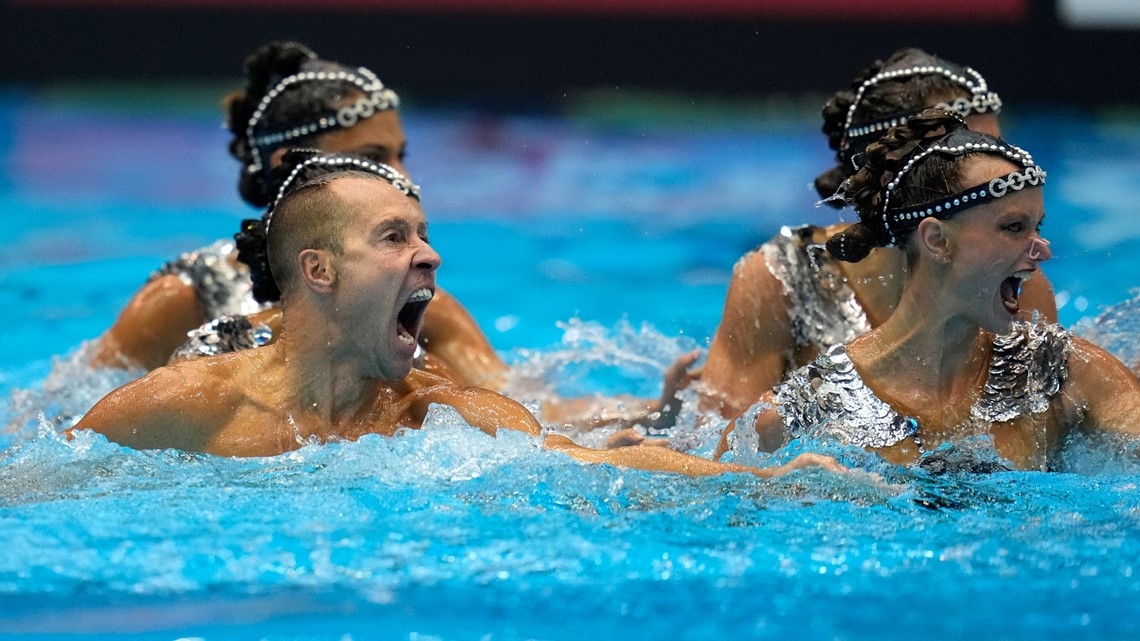FUKUOKA, Japan — Snicker if you wish. Guffaw for good measure. Bill May and other male synchronized swimmers — now called artistic swimmers — have heard the putdowns before.
But they're getting the last laugh.
Men have competed in synchro at the lower levels for decades. Now they're being included in the Olympics, meaning next year's Summer Games in Paris.
“I think it's a huge opportunity for the sport to grow and attract more men," May told the Associated Press at the World Aquatics Championships. “By keeping men out you're limiting the sport. By including men you're going to see an upshift in the popularity and the numbers.”
May looks like a lean bodybuilder. He was among the first men to compete when synchro was included in the worlds for the first time in 2015. And he worked for 17 years at Cirque du Soleil doing water-themed shows. He has come out of competitive retirement for a chance to compete at the Olympics.
“There has always been that misconception that it’s a female-only sport, or that it’s for wimps, or that it’s not a difficult sport,” the 44-year-old May said. “Anyone that has anything negative to say about the sport — boy, female, anyone. Just try it and you’ll know it’s the most difficult sport in the world.”


This is not the synchronized swimming that your parents or grandparents watched — the water ballet that made few waves below the flowery rubber caps and permanent smiles, It's estranged from the sport introduced at the 1984 Los Angeles Olympics.
The acrobatic team event, in particular, features lifts, throws and flips, and diving routines launched off the shoulders of teammates treading water below. It's gymnastics on water and concussions are a risk.
Interested men often confront the stereotypes.
Beginning in elementary school, 18-year-old American Kenny Gaudet dreamed of being a synchronized swimmer. He made it, but it wasn't easy.
“It makes me emotional just to think about the problems we all went through and the struggles we all had just to get a chance to swim and do what we love," said Gaudet who competed at this year's worlds.
“So much bullying. So much slander. So much hate,” he added. "Just because of my gender, just because I’m a male in artistic swimming. When I first started I wanted to quit so many times. Growing up my peers would ask why I’m doing a female sport, why am I being like a girl and degrade me for doing what I love to do.”
One aspect of Adam Andrasko's job as the head of USA Artistic Swimming is recruiting men. He said there are about 100 participating in the United States, up from 25 just four years ago.
“There hasn’t been a good foundation of growth," Andrasko said. “You haven’t had the farm system.”
A few countries at the world championships have male swimmers including the United States, Japan, Germany and China. Spain and Italy also have top competitors.
“There aren’t a lot of countries with strong males," in the international competition, Andrasko said, noting men often lack the flexibility to compete. “So you might not see a lot of males swimming in the Olympics. I’m concerned it goes to the Olympic Games and we don’t see a male participating. I definitely have that fear.”
“To this point," he added, “women are still far better at this sport than a man.”
Another fear, apparently unfounded, is that women might resent the men competing in the sport. Men will compete in only team events at the Olympics. Teams have a maximum of eight members — with a limit of two men — which means men might crowd out some women.
There is no requirement for men to be included.
Asked about any acrimony, two-time American Olympian Anita Alvarez replied: “No, not at all.”
Alvarez has blacked out twice in the last two years while competing and had to be resuscitated. She's been cleared to compete with no diagnosis except physical or mental exhaustion. Holding her breath for too long underwater is also suspected.
Men can add some physicality to routines, and their presence could lead to a wider audience. Alvarez also credits May with choreography skills that he picked up with Cirque du Soleil.
“Having the inclusion of both males and females will make it more open for young boys and young girls to dream of being in the Olympics, parents wanting to start their kids,” Alvarez said.
She ran off her workout routine, sure to scare away men and women — equally.
“We're training eight-plus hours a day, treading water all day,” she said. “You have to be able to count time and work with music. You have to be able to watch your patterns and stay in line. We don't wear goggles when we compete. You're holding your breath. You don't touch the bottom. There are so many elements that go into it that people don't see.”
And we're about to see more men trying it.
.png)









 English (US) ·
English (US) ·